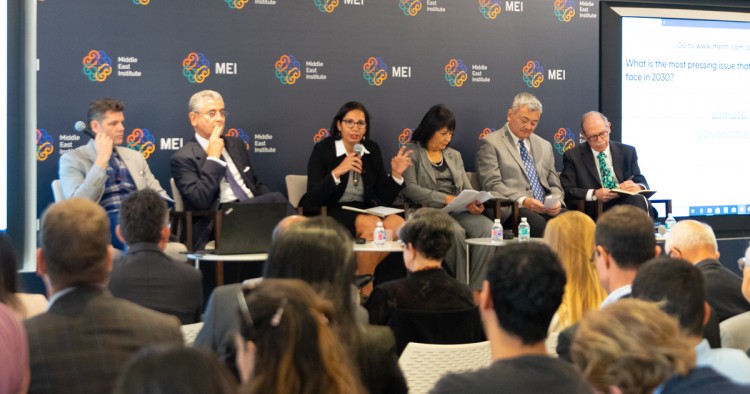As part of our Grand Opening week, inaugurating the newly renovated historic headquarters of the Institute on N St., NW, MEI hosted a conference intended to identify and, if possible, address the critical challenges confronting the Middle East through the year 2030. The conference featured two expert panels on identifying trends and trajectories over the next ten years and then looking at the policy options that might be available to U.S. decision-makers and regional leaders. In addition, the Institute welcomed H.E. Dr. Thani Ahmed al-Zeyoudi, the UAE minister of climate change and environment, to the conference as a keynote speaker.
In concept, MEI sought to structure the Futures Conference as a new and different approach to an identified set of problems. Many conferences and studies focus on “the future” of a topic. The purpose of this conference was different. The aim was to explore some of the bounds of strategic foresight about our topic: the Middle East and North Africa (MENA) region over the period 2020-30. There are numerous foreseeable challenges — and opportunities — for MENA in terms of security and stability, governance, climate, workforce and education, social dynamics, and demographics. Strategic foresight is the thoughtful consideration of the variety of ways that such challenges and opportunities could play out. As a starting point, we provided the panelists with some trend projections about MENA circa 2030. Together they represented a “most likely” future for the region. Trends, inherently, are linear — they assume developments will continue on their current trajectories. They are important to examine. But the future is not linear, nor is strategic foresight. The challenge we put to our panelists, attendees, and ourselves to consider was: what policies and other actions could the U.S. and regional actors pursue that could shift these trajectories, creating alternate futures?
One of the critical elements of strategic foresight then is recognizing that trends and trajectories don’t occur in a vacuum. The diverse issues affect one another and twist and turn future events based on their interaction. Rapid population growth not only engenders both risks and opportunities for economic development, it similarly alters projections for political stability and the threat of violent extremism. Likewise, if societies can tackle the challenge of climate change, they can build the cities of tomorrow and create a better future for their citizens. Left untended, though, the region’s future might be a dystopian nightmare of uninhabitable cities and blasted civilizations. In turn, that will drive migration and refugee populations, radiating instability to the rest of the world. That potential impact of regional developments on global stability — the recognition that there can be no “America First” strategy of building a wall around ourselves; the world can’t turn away from its interdependence — was one of the most important takeaways from the discussions. In the end, as one of the participants noted, the challenge for us in considering how to adjust the trend lines in the Middle East to promote positive outcomes is not to encourage “out-of-the-box thinking” but instead, it is to “blow up the box” and visualize new answers.
How did we do in our Futures Conference? The discussions are online on the MEI website and we invite you to watch and decide for yourself.
Amb. (ret.) Gerald Feierstein is MEI’s senior vice president.
Photo from MEI
The Middle East Institute (MEI) is an independent, non-partisan, non-for-profit, educational organization. It does not engage in advocacy and its scholars’ opinions are their own. MEI welcomes financial donations, but retains sole editorial control over its work and its publications reflect only the authors’ views. For a listing of MEI donors, please click here.













